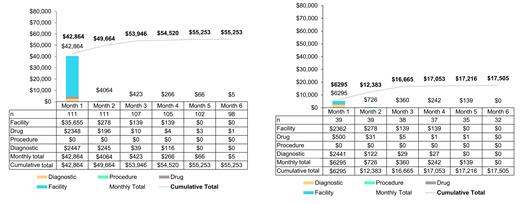Background:CAR T cell therapy administration is often in an inpatient (IP) setting due to the possibility of severe AEs after infusion. Lisocabtagene maraleucel (liso-cel) is an autologous, CD19-directed, 4-1BB CAR T cell product administered at equal target doses of CD8 + andCD4 + CAR + T cells. Outpatient (OP) administration of liso-cel is feasible given trial-demonstrated low rates of grade ≥ 3 AEs that require hospitalization, including cytokine release syndrome and neurological events (Bachier CR, et al. J Clin Oncol 2020). Follow-up care in the OP setting may differ from that in an IP setting and may offer an opportunity to reduce AE management-related health care resource utilization (HCRU) and costs; limited data is published on this topic. Thus, this study assessed postinfusion monitoring HCRU and costs by site of care (ie, IP/OP) among patients with R/R large B-cell lymphoma (LBCL) treated with liso-cel as second-line (2L) therapy in TRANSFORM (NCT03575351) and PILOT (NCT03483103) clinical trials.
Methods: A microcosting methodology was used to assess postinfusion monitoring-related HCRU identified from pooled TRANSFORM and PILOT case report forms and to estimate associated costs (excluding liso-cel acquisition costs) by site of care using a 6-month time frame, beginning on the liso-cel infusion date. HCRU data were analyzed in the 6 months after infusion, including facility (eg, number of standard IP and ICU hospitalizations and length of stay [LOS]), procedures (eg, dialysis or intubation/mechanical ventilation), diagnostics (eg, imaging or laboratory tests), and medication use (eg, tocilizumab or corticosteroids). Unit costs were then applied to each HCRU. Unit costs were assessed from the health care system perspective, derived from publicly available databases (eg, United States [US] Centers for Medicare & Medicaid Services, Healthcare Cost and Utilization Project, and IBM ® Micromedex ® RED BOOK ®) or peer-reviewed literature, and adjusted to 2021 US dollars using the medical component of the Consumer Price Index. Patients were considered OP if discharged on the day of infusion or at the end of the observation period.
Results: Among 150 patients treated with liso-cel, 111 (74%) were infused as IPs and 39 (26%) as OPs. Estimated median 6-month total postinfusion monitoring costs were $55,253 in the IP setting and $17,505 in the OP setting, reflecting a reduction of $37,748 for OP site of care (Figure). Among patients cared for in the OP setting who required subsequent hospitalization (19/39 [49%]), the median total LOS was 7 days shorter than patients cared for in the IP setting who required hospitalization (105/111 [95%]) (OP: 7 days [range, 1-33] vs IP: 14 days [range, 1-164]). Facility costs, especially hospitalizations, were the largest contributor to overall median 6-month costs in both the IP setting ($40,501; 73%) and the OP setting ($5697; 33%). The majority of total costs occurred in Month 1 postinfusion for patients in both settings. For patients receiving care in the IP setting, 78% ($42,864) of median costs were incurred within the first month after infusion; for OPs, 36% ($6295) of median costs were incurred within Month 1. Patients in the IP setting had higher rates of key HCRU than in the OP setting, respectively, for the following: standard IP hospitalizations (105/111 [95%] vs 19/39 [49%]), ICU admissions (10/111 [9%] vs 0/39 [0%]), any tocilizumab use (32/111 [29%] vs 5/39 [13%]), and any corticosteroid use (54/111 [49%] vs 17/39 [44%]). Patients in the OP setting had higher rates compared with the IP setting, respectively, for office visits (37/39 [95%] vs 87/111 [78%]) and intubation (2/39 [5%] vs 0/111 [0%]).
Conclusions: Among patients with R/R LBCL treated with liso-cel in the 2L TRANSFORM and PILOT trials, estimated median 6-month postinfusion costs were 68% lower for patients cared for in the OP versus IP setting. These results are consistent with a previous analysis of patients treated with liso-cel in the third-line setting (Palomba ML, et al. Leuk Lymphoma 2021); and thus, further support that OP postinfusion monitoring and care may allow health care systems to optimize HCRU and costs for patients with LBCL who receive CAR T cell therapy.
Disclosures
McGarvey:Bristol Myers Squibb: Research Funding. Gitlin:Bristol Myers Squibb: Research Funding. Lee:Bristol Myers Squibb: Research Funding. Keating:Bristol Myers Squibb: Divested equity in a private or publicly-traded company in the past 24 months, Ended employment in the past 24 months. Barghout:Sun Pharma: Consultancy; Regeneron: Consultancy; Novartis: Consultancy; Taiho: Consultancy; Bristol Myers Squibb: Consultancy. Tiwana:Bristol Myers Squibb: Current Employment, Current equity holder in publicly-traded company.


This feature is available to Subscribers Only
Sign In or Create an Account Close Modal